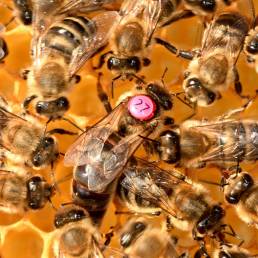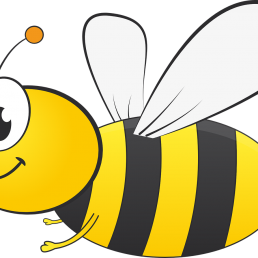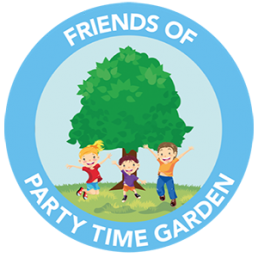Queenie, the Honey Bee
Queenie is in charge of the hive and all honey making activities at Partytime Garden. She rules for her hive hidden in the woods making sure all our honey is up to her high standards.
Honey bees, also known as “honeybees,” are a group of insect species in the genus Apis. These insects are eusocial, which means they form large, complex societies. They are best known for building hives to store honey, and it is common to farm them for this reason. While they are not the only bees that can produce honey, the only true “honeybees” are in the genus Apis

Description
There are 7 different species of honey bees, and 44 different subspecies. Each species and subspecies has its own minute differences in appearance. However, all have the same basic anatomy.
Their bodies consist of a head, thorax (or midsection), and abdomen (or rear section). The first section, the head, contains a pair of antennae, and mouthparts. Next, the thorax is where the wings and six legs, attach to the body. Finally, the famous stinger is at the end of the abdomen.
Diet
The only nutrition that honeybees receive is nectar and pollen from flowers. Pollen is the only protein source that they consume, and nectar provides water and energy. They collect food by flying to areas with lots of flowers, and moving from flower to flower harvesting nectar and pollen.
If they find a new patch of flowers, they return to the nest and show the other bees where to go by dancing. Scientists call the dance that bees use to communicate with one another a “waggle dance.”
Habitat
These insects require habitats with plenty of feeding opportunities nearby, namely, flowering plants. They can live in natural habitats, agricultural areas, and urban parks or gardens. Their preferred habitats include orchards, meadows, gardens, woodlands, and virtually anywhere with plenty of flowers growing.
Honey bees are also capable of surviving in cold climates, and thermoregulate by huddling within the nest. The bees actually shiver to increase the temperature inside the hive.
Different species of honey bees live in different regions of the world. Each species has its own unique range. While some species are common, others have grown quite rare. The dwarf and black dwarf species are both native to Southeast Asia. The giant species lives in both South and Southeast Asia.
The eastern species lives throughout southern and southeastern Asia. Koschevnikov’s bee lives in Malaysia and Borneo. The European species is the most common, and resides on every continent except for Antarctica. Finally, the Philippine honey bee lives in the Philippines and Indonesia.
Did You Know?
- All worker bees are female.
- A bee produces a teaspoon of honey (about 5 grams) in her lifetime.
- To produce a kilogram of honey, bees fly the equivalent of three times around the world in air miles.
- The type of flower the bees take their nectar from determines the honey’s flavour.
- Male bees (drones) have bigger eyes to help them find the Queen Bee.
- Bees mate high in the sky. Afterwards the male bee loses his reproductive organs and dies.
- A Queen Bee can produce 2,000 eggs a day. Fertilised eggs become females and unfertilised eggs become males, with the help of pheromones.
- To get more bees in your garden grow more colour.
- Bees love blue and love cluster plants like lavender and rosemary.
- Bees don’t want to sting you because they die.
- There are over 20,000 different species of bee, found on every continent except Antarctica.
- Honey has been shown to have many health benefits both when eaten and when applied to the skin. The darker the honey the better.
- The bee is the only social insect to be partially domesticated by humans

Cartoon Queenie
While Queenie is busy ruling her hive and managing honey production we have turned her into a cool cartoon character. She will help you understand how bees live and work together in harmony and how they help humans. While they are ever so small they are an important part of the natural world. With our bees flowers would not get pollinated which is a big word meaning they could not produce the food we need.
So the lesson is is bees are in trouble then we all are in trouble so lets look after each other.
Get Involved
Bee....come a Volunteer
Why Not help us look after Queenie and her friends. Each year at the Garden our animals are fed and cared for by volunteers supported by the public. So if your would like to help us care for our animals. Why not come and join our bee-keepers as they tend to the hives and learn one of the oldest crafts in the world.
